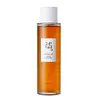What's inside
What's inside
 Key Ingredients
Key Ingredients

 Benefits
Benefits

 Concerns
Concerns

No concerns
 Ingredients Side-by-side
Ingredients Side-by-side

Panax Ginseng Root Water
MaskingButylene Glycol
HumectantGlycerin
HumectantPropanediol
SolventNiacinamide
Smoothing1,2-Hexanediol
Skin ConditioningWater
Skin ConditioningHydroxyacetophenone
AntioxidantGlyceryl Glucoside
HumectantXanthan Gum
EmulsifyingPanthenol
Skin ConditioningDipotassium Glycyrrhizate
HumectantAllantoin
Skin ConditioningAdenosine
Skin ConditioningPanax Ginseng Callus Culture Extract
Skin ConditioningTheobroma Cacao Extract
Skin ConditioningDextrin
AbsorbentGlucose
HumectantPanax Ginseng Root Extract
EmollientPanax Ginseng Berry Extract
Skin ConditioningLactobacillus
Skin ConditioningSodium Hyaluronate
HumectantEthylhexylglycerin
Skin ConditioningDisodium EDTA
Panax Ginseng Root Water, Butylene Glycol, Glycerin, Propanediol, Niacinamide, 1,2-Hexanediol, Water, Hydroxyacetophenone, Glyceryl Glucoside, Xanthan Gum, Panthenol, Dipotassium Glycyrrhizate, Allantoin, Adenosine, Panax Ginseng Callus Culture Extract, Theobroma Cacao Extract, Dextrin, Glucose, Panax Ginseng Root Extract, Panax Ginseng Berry Extract, Lactobacillus, Sodium Hyaluronate, Ethylhexylglycerin, Disodium EDTA
Water
Skin ConditioningGlycerin
HumectantPropylene Glycol
HumectantButylene Glycol
HumectantPotassium Phosphate
BufferingPolysorbate 80
EmulsifyingPhenoxyethanol
PreservativeSodium Chloride
MaskingHexylene Glycol
EmulsifyingDipotassium Phosphate
BufferingPolyglyceryl-4 Caprate
EmulsifyingSodium Hyaluronate
HumectantPeumus Boldus Leaf Extract
MaskingDisodium EDTA
Olea Europaea Leaf Extract
PerfumingMyrtrimonium Bromide
PreservativeBenzophenone-4
UV AbsorberRosmarinus Officinalis Leaf Extract
AntimicrobialParfum
MaskingXanthan Gum
EmulsifyingCitrus Grandis Fruit Extract
AstringentSodium Benzoate
MaskingCucumis Sativus Fruit Extract
EmollientThymus Vulgaris Flower/Leaf Extract
MaskingLactic Acid
BufferingBenzyl Benzoate
AntimicrobialPotassium Sorbate
PreservativeBenzyl Alcohol
PerfumingAlpha-Isomethyl Ionone
PerfumingMorus Alba Root Extract
BleachingLinalool
PerfumingCI 42090
Cosmetic ColorantCI 19140
Cosmetic ColorantWater, Glycerin, Propylene Glycol, Butylene Glycol, Potassium Phosphate, Polysorbate 80, Phenoxyethanol, Sodium Chloride, Hexylene Glycol, Dipotassium Phosphate, Polyglyceryl-4 Caprate, Sodium Hyaluronate, Peumus Boldus Leaf Extract, Disodium EDTA, Olea Europaea Leaf Extract, Myrtrimonium Bromide, Benzophenone-4, Rosmarinus Officinalis Leaf Extract, Parfum, Xanthan Gum, Citrus Grandis Fruit Extract, Sodium Benzoate, Cucumis Sativus Fruit Extract, Thymus Vulgaris Flower/Leaf Extract, Lactic Acid, Benzyl Benzoate, Potassium Sorbate, Benzyl Alcohol, Alpha-Isomethyl Ionone, Morus Alba Root Extract, Linalool, CI 42090, CI 19140
 Reviews
Reviews

Ingredients Explained
These ingredients are found in both products.
Ingredients higher up in an ingredient list are typically present in a larger amount.
Butylene Glycol (or BG) is used within cosmetic products for a few different reasons:
Overall, Butylene Glycol is a safe and well-rounded ingredient that works well with other ingredients.
Though this ingredient works well with most skin types, some people with sensitive skin may experience a reaction such as allergic rashes, closed comedones, or itchiness.
Learn more about Butylene GlycolDisodium EDTA plays a role in making products more stable by aiding other preservatives.
It is a chelating agent, meaning it neutralizes metal ions that may be found in a product.
Disodium EDTA is a salt of edetic acid and is found to be safe in cosmetic ingredients.
Learn more about Disodium EDTAGlycerin is already naturally found in your skin. It helps moisturize and protect your skin.
A study from 2016 found glycerin to be more effective as a humectant than AHAs and hyaluronic acid.
As a humectant, it helps the skin stay hydrated by pulling moisture to your skin. The low molecular weight of glycerin allows it to pull moisture into the deeper layers of your skin.
Hydrated skin improves your skin barrier; Your skin barrier helps protect against irritants and bacteria.
Glycerin has also been found to have antimicrobial and antiviral properties. Due to these properties, glycerin is often used in wound and burn treatments.
In cosmetics, glycerin is usually derived from plants such as soybean or palm. However, it can also be sourced from animals, such as tallow or animal fat.
This ingredient is organic, colorless, odorless, and non-toxic.
Glycerin is the name for this ingredient in American English. British English uses Glycerol/Glycerine.
Learn more about GlycerinSodium Hyaluronate is hyaluronic acid's salt form. It is commonly derived from the sodium salt of hyaluronic acid.
Like hyaluronic acid, it is great at holding water and acts as a humectant. This makes it a great skin hydrating ingredient.
Sodium Hyaluronate is naturally occurring in our bodies and is mostly found in eye fluid and joints.
These are some other common types of Hyaluronic Acid:
Learn more about Sodium HyaluronateWater. It's the most common cosmetic ingredient of all. You'll usually see it at the top of ingredient lists, meaning that it makes up the largest part of the product.
So why is it so popular? Water most often acts as a solvent - this means that it helps dissolve other ingredients into the formulation.
You'll also recognize water as that liquid we all need to stay alive. If you see this, drink a glass of water. Stay hydrated!
Learn more about WaterXanthan gum is used as a stabilizer and thickener within cosmetic products. It helps give products a sticky, thick feeling - preventing them from being too runny.
On the technical side of things, xanthan gum is a polysaccharide - a combination consisting of multiple sugar molecules bonded together.
Xanthan gum is a pretty common and great ingredient. It is a natural, non-toxic, non-irritating ingredient that is also commonly used in food products.
Learn more about Xanthan Gum